List of dukes in Europe
The following is a list of historic dukedoms in Europe:
Austria
The Austrian lands:
- the Duchies of Austria proper
- the Duchy of Carinthia (today in Austria and Slovenia)
- the Duchy of Styria (today in Austria and Slovenia)
- the Duchy of Carniola (today Slovenia).
The Habsburg dukes came to style themselves Archdukes.
| Arms | Title | Date of creation | Creating sovereign | Current holder | Notes |
|---|---|---|---|---|---|
_Wappen_1909.png) | Duchess of Hohenberg | 4 October 1909 | Franz Josef I of Austria | created for Sophie, Princess of Hohenberg (for life, extinct in 1914) | |
 | Duke of Hohenberg | 31 August 1917 | Karl I of Austria | Georg, Duke of Hohenberg | created for Prince Max of Hohenberg (hereditary in the primogeniture) |
Bohemia
The Czech lands:
- the Duchy of Bohemia
- the Duchies of Silesia
The Duchy of Bohemia became Kingdom of Bohemia in 1212.
France
Royal dukes
Non-royal dukes
| Arms | Title | Date of creation | Creating sovereign | Current holder | Notes |
|---|---|---|---|---|---|
.svg.png) | Dukes of Uzès | 1572 | Charles IX of France | Jacques de Crussol d'Uzès | |
 | Duchy of Montbazon | 1588 | Henry III of France | Albert Marie de Rohan-Rochefort | |
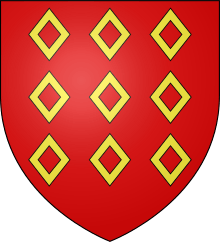 | Duke of Rohan | 1603 | Henry IV of France | Josselin de Rohan | |
 | Duke of Brissac | 1611 | Louis XIII of France | François de Cossé-Brissac, 13th Duke of Brissac | |
 | Duke of Luynes | 1619 | Louis XIII of France | Philippe d'Albert, 13th duc de Luynes | |
.svg.png) | Duke of Chevreuse Duke of Chaulnes | 1545 1621 | Francis I of France Louis XIII of France | Jacques François Marie Raymond d'Albert de Luynes, 13th duc de Chaulnes | |
.svg.png) | Duke of La Force | 1637 | Louis XIII of France | Henri Jacques Nompar de Caumont La Force | |
.svg.png) | Duke of Estrées | 1663 | Louis XIV of France | Armand-Sosthènes de La Rochefoucauld-Doudeauville | |
 | Duke of Noailles Dukes of Ayen | 1663 1737 | Louis XIV of France Louis XV of France | Hélie Marie Auguste Jacques Bertrand Philippe de Noailles, 10th Duke of Noailles | |
 | Duke of Broglie | 1742 | Louis XV of France | Philippe-Maurice, 9th duc de Broglie | |
| Duke of Montebello | 1808 | Napoleon I of France | Maurice Georges Antoine Marie Lannes, 7th Duke of Montebello | ||
| Dukes of Magenta | 1859 | Napoleon III of France | Maurice Marie Patrick Bacchus Humphrey de MacMahon, 5th Duc de Magenta |
Germany
Although the titled aristocracy of Germany no longer holds a legal rank, nearly all ducal families in Germany continued to be treated as dynastic (i.e., "royalty") for marital and genealogical purposes after 1918. Some maintain dynastic traditions that are reflected in roles they still play in high society networks, philanthropy and Germany's version of local "squirearchy" visibility.
At first, the highest nobles – de facto equal to kings and emperors – were the Dukes of the stem duchies:
- Duchy of Saxony (now Lower Saxony)
- Duchy of Franconia
- Duchy of Bavaria
- Duchy of Swabia
- Duchy of Lorraine (replacing Duchy of Thuringia)
Later, the precedence shifted to the prince-electors, the first order amongst the princes of the empire, regardless of the actual title attached to the fief. This college originally included only one Duke, the Duke of Saxony. The ducal title, however, was not limited by primogeniture in the post-medieval era. All descendants in the male line, including females, shared the original title, but each male added as a suffix the name of his inherited domain to distinguish his line from that of other branches. From the 19th century, some cadets of the kingly houses of Bavaria and Württemberg, and all those of the grand-ducal houses of Mecklenburg-Schwerin, Mecklenburg-Strelitz and Oldenburg, took the ducal prefix as their primary style instead of that of Prince (Prinz).
There were many other duchies, some of them insignificant petty states (Kleinstaaterei):
- Duchy of Bavaria, elector since 1623
- Duchy of Bremen (1648–1806)
- Duchy of Brunswick-Lüneburg, divided into various lines, one of which became the electorate of Hanover in 1692, another became the independent Duchy of Brunswick in 1815.
- Duchy of Franconia, the secular title of the Bishop of Würzburg
- Duchy of Holstein, in union with Schleswig, in personal union with the Danish crown.
- Duchy of Jülich and Berg
- Duchy of Lorraine
- Duchy of Magdeburg, the former prince-archbishopric after being acquired by Brandenburg-Prussia in 1680
- Duchy of Mecklenburg, later divided into various lines
- Duchy of Pomerania
- Grand Duchy of Salzburg, the secularized prince-archbishopric 1803–1806
- Duchies of Saxony, in Lower Saxony and Upper Saxony, the successor state(s) of the original (stem)duchy of Saxony after dismissal of Duke Henry the Lion by the Emperor, collateral lines of the electoral line (to wit: the Lower Saxon Saxe-Lauenburg and the Upper Saxon Saxe-Altenburg, Saxe-Coburg and Gotha, Saxe-Eisenach, Saxe-Eisenberg, Saxe-Gotha, Saxe-Hildburghausen, Saxe-Jena, Saxe-Meiningen, Saxe-Römhild, Saxe-Saalfeld, Saxe-Weimar, Saxe-Weimar-Eisenach, Saxe-Weissenfels, and Saxe-Wittenberg)
- Duchy of Silesia
- Duchy of Westphalia, a territory under the Archbishop of Cologne, either a successor-state of the original Duchy of Saxony, which was divided into Eastphalia (which later became Brunswick-Lüneburg), Engern and Westphalia
- Duchy of Württemberg, became an electorate in 1803
- Duchy of Zweibrücken
Ruling Dukes (as of 1918)
| Arms | Title | Date of creation | Ducal House | Current pretender | Notes |
|---|---|---|---|---|---|
 | Duke of Saxe-Meiningen | 30 August 1680 | House of Wettin | Konrad, Prince of Saxe-Meiningen | |
 | Duke of Brunswick | 22 December 1813 | House of Hanover | Prince Ernst August of Hanover | |
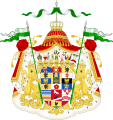 | Duke of Saxe-Altenburg | 12 November 1826 | House of Wettin | Raymond II, Prince of Saxe-Altenburg | |
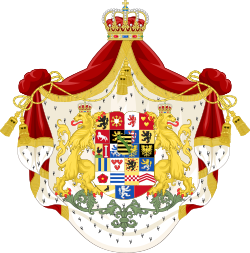 | Duke of Saxe-Coburg and Gotha | 12 November 1826 | House of Wettin | Andreas, Prince of Saxe-Coburg and Gotha | |
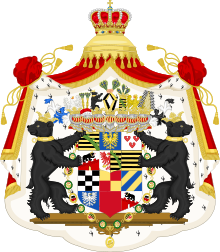 | Duke of Anhalt | 30 August 1863 | House of Ascania | Eduard, Prince of Anhalt |
Non-ruling Dukes
| Arms | Title | Date of creation | Ducal House | Current holder | Notes |
|---|---|---|---|---|---|
 | Duke of Leuchtenberg | 14 November 1817 | House of Beauharnais | extinct 1974 | |
 | Duke of Schleswig-Holstein-Sonderburg-Glücksburg | 6 July 1825 | House of Glücksburg | Christoph, Prince of Schleswig-Holstein | |
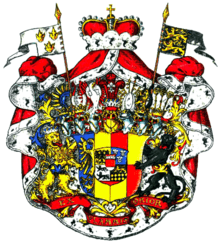 | Duke of Ratibor | 15 October 1840 | House of Hohenlohe-Schillingsfürst | Viktor Metternich-Sándor, 5th Duke of Ratibor and Prince of Corvey | |
 | Duke of Ujest | 18 October 1861 | House of Hohenlohe-Oehringen | Kraft, 5th Duke of Ujest and Prince of Hohenlohe-Oehringen | |
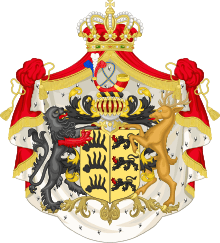 | Duke of Urach | 28 March 1867 | House of Urach | Wilhelm Albert, Duke of Urach | |
 | Duke of Trachenberg | 1 January 1900 | House of Hatzfeldt-Trachenberg | Sebastian, 4th Duke of Trachenberg and Prince of Hatzfeldt | |
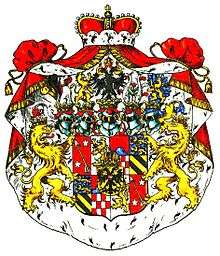 | Duke of Pless | 20 December 1905 | House of Hochberg | Bolko, Duke of Pless | |
On the Baltic south coast
- The duchy of Pomerellen (Pomerelia; capital Danzig (Gdańsk), now in Poland) was part of the State of the Teutonic Order until its takeover by the Polish Crown in 1466.
- The duchy of Courland (now in Latvia) was a Polish vassal state and once a colonial power from its foundation in 1562 for the last Master of Livonian Order, Gotthard Kettler, until 1795.
- The Ordensstaat became the Duchy of Prussia in 1525, part of the dynastic home country of the later German (Hohenzollern) Emperor.
The Low countries (Netherlands/Belgium/Luxembourg)
- Duchy of Brabant
- Duchy of Guelders
- Duchy of Bouillon in the Ardenne
- Duchy of Luxembourg
| Arms | Title | Date of creation | Ducal House | Current holder | Notes |
|---|---|---|---|---|---|
 | Duke of Brabant | 1183 | Belgian Royal Family (Crown Prince(ss) of Belgium) | Princess Elisabeth, Duchess of Brabant | |
| Duke of Arenberg Duke of Aarschot | House of Arenberg | Léopold, 13th Duke of Arenberg | |||
 | Duke of Beaufort-Spontin | 1782 | Beaufort-Spontin | Friedrich Christian, 7th Duke of Beaufort-Spontin | |
.svg.png) | Duke of Croÿ | 1767 | House of Croÿ | Rudolf, 15th Duke of Croÿ | |
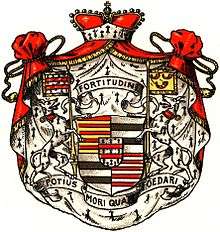 | Duke of Looz-Corswarem | 1734 | Looz-Corswarem | Thierry, Duke of Looz-Corswarem | |
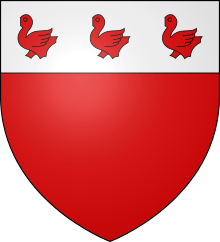 | Duke of Ursel | 1717 | House of Ursel | Stéphane, 10th Duke d'Ursel |
Greece
| Arms | Title | Date of creation | Ducal House | Current pretender | Notes |
|---|---|---|---|---|---|
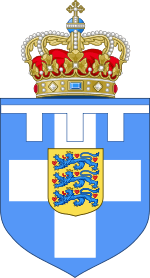 | Duke of Sparta | 1868 | Greek Royal Family (Constantine I of Greece) | none |
Italy
Kingdom of the Lombards
The Kingdom of the Lombards was divided in several duchies, as follows:
- Duchy of Friuli
- Duchy of Ceneda
- Duchy of Treviso
- Duchy of Vicenza
- Duchy of Verona
- Duchy of Trent
- Duchy of Parma
- Duchy of Reggio
- Duchy of Piacenza
- Duchy of Brescia
- Duchy of Bergamo
- Duchy of Milan
- Duchy of Pavia
- Duchy of San Giulio
- Duchy of Asti
- Duchy of Turin
- Duchy of Ivrea
- Duchy of Aosta
- Duchy of Tuscany
- Duchy of Spoleto
- Duchy of Benevento (787–873 under Frankish suzerainty, then again Byzantine; later a principality, since 1051 held from the Pope)
They have been suppressed or transformed in counties as consequence of the Frankish conquest of the Kingdom in 776. Only the two southern duchies of Spoleto and Benevento were spared and survived some centuries.
Exarchate of Ravenna
In the same period (the Early Middle Ages) also many Italian territories under Byzantine suzerainty (in the Exarchate of Ravenna) were organized in duchies, and notably the following ones:
The first four were Tyrrhenian port cities and survived as semi-autonomous states until the Norman conquest of Southern Italy in the 11th and 12th centuries. The Duchy of Rome was transformed in the Papal State as consequence of the Donation of Sutri in 728. The Duchy of Venice became the Republic of Venice and its head of state retained the title of doge, equivalent to that of duke.
In 1059 Robert Guiscard, head of the Norman House of Hauteville, was created by the Pope Duke of Apulia and Calabria. When the State was raised to Kingdom of Sicily in 1180, the title of Duke of Apulia and Calabria was used intermittently for the heir to throne.
Kingdom of Italy (medieval)
Since 1395 the major Signorias of the Kingdom of Italy (which was part of the Holy Roman Empire) began to be raised to Dukedoms by the Emperor. By the centuries more and more Dukedoms were created in this way and they became de facto sovereign states. The Duchies created after 1395 were the following ones:
- Duchy of Milan
- Duchy of Mantua
- Duchy of Sabbioneta
- Duchy of Montferrat
- Duchy of Guastalla
- Duchy of Modena and Reggio
- Duchy of Mirandola
- Duchy of Florence then Grand Duchy of Tuscany
- Duchy of Massa and Carrara
The Duchy of Savoy, though it was not an Italian state, had suzerainty on Piedmont.[1]
Papal States
Also the Pope created some sovereign duchy during the Renaissance, notably:
- Duchy of Ferrara
- Duchy of Urbino
- Duchy of Camerino
- Duchy of Castro
- Duchy of Parma
Kingdom of Naples
While the King of Naples created only one, the Duchy of Sora.[2]
- See also Historical states of Italy
In the Papal states and in the Kingdoms of Naples and Sicily the Pope and the king, respectively, granted the title of duke as the second rank of nobility, just inferior to that of prince. These dukes, however, always remained vassals.
They include:
- Duchy of Acerenza, created by the Kings of Spain and Naples for the ancestors of the Prince Belmonte
- Duchy of San Donato, created by the Kings of Spain and Naples for the ancestors of the Prince Sanseverino
- Duke of Calabria was the primogeniture for the crown prince of the Neapolitan kingdom.
Since 1081 the Duchies of Benevento and Pontecorvo had been two among the Papal states, and, in fact, no duke was appointed.
Kingdom of Italy (Napoleonic)
A unique Napoleonic particularity was the creation by decree of 30 March 1806 of a number of duchés grand-fiefs. As the name suggests, these were duchies, but forming an exclusive order of 'great fiefs' (twenty among some 2200 noble title creations), a college nearly comparable in status to the original anciennes pairies in the French kingdom. Since Napoleon I wouldn't go back on the Revolution's policy of abolishing feudalism in France, but didn't want these grandees to fall under the 'majorat' system in France either, he chose to create them outside the French "metropolitan" empire, notably in the following Italian satellite states, and yet all awarded to loyal Frenchmen, mainly high military officers:
In the Kingdom of Italy, in personal union with France, personally held by Napoleon I:
- Dalmatia (now in Croatia): for maréchal Nicolas Jean de Dieu Soult (1808, extinguished 1857)
- Istria (now in Croatia): for maréchal Jean-Baptiste Bessières (1809, ext. 1856)
- Frioul, i.e. Friuli: for the widow of general Geraud Christophe Michel Duroc (1813, ext. 1829)
- Cadore: for Admiral Jean-Baptiste Nompère de Champagny (ext. 1893)
- Bellune, i.e. Belluno: for maréchal Victor (1808, ext. 1853)
- Conegliano: for maréchal Bon Adrien Jeannot de Moncey (1808, ext. 1842)
- Trévise, i.e. Treviso: for maréchal Édouard Adolphe Casimir Joseph Mortier (1808, ext. 1912)
- Feltre: for general Clarke (ext. 1852, extended 1864)
- Bassano: for Hugues-Bernard Maret, minister (ext. 1906)
- Vicence, i.e. Vicenza: for general Armand Augustin Louis de Caulaincourt, also imperial Grand-Écuyer (ext. 1896)
- Padoue, i.e. Padua (Padova in Italian): for general Jean-Toussaint Arrighi de Casanova (24 April 1808, ext. 1888)
- Rovigo: for general Anne Jean Marie René Savary (extinguished in 1872)
In the Principality of Lucca and Piombino, only Massa et Carrara: for Régnier, judge (extinguished 1962); Massa and Carrara were separated from the kingdom of Italy by article 8 of the decree of March 30, 1806 and united to the principality of Lucca-Piombino by another decree of March 30, 1806.
In the Kingdom of Naples :
- Gaete, i.e. Gaeta: for Martin-Michel-Charles Gaudin, finance minister (1809, extinguished 1841)
- Otrante, i.e. Otranto: for Joseph Fouché, minister of Police (1809)
- Reggio: for maréchal Charles Nicolas Oudinot (1810, main line extinguished 1956, but special clause of the letters patent authorizing a substitution were applied)
- Tarente, i.e. Tarento: for maréchal Étienne-Jacques-Joseph-Alexandre MacDonald (1809, extinguished 1912)
In the states of Parma and Piacenza, ceded to France by the treaty of Aranjuez of 21 March 1801, shortly before both territories were united to the French Empire on 24 May 1808:
- Parme, i.e. Parma: for lawyer Jean Jacques Régis de Cambacérès, author of the Code (the main European revision since Roman law, still influential in most democratic societies), Arch-Chancellor (24 April 1808, extinguished 1824)
- Plaisance, i.e. Piacenza: for Charles-François Lebrun, also imperial Arch-Treasurer (24 April 1808, extinguished 1926)
- Guastalla: for Camillo Borghese, brother-in-law to Napoleon I (30 March 1806, extinguished 1832)
In 1815 the Congress of Vienna created the last Italian sovereign duchy, the Duchy of Lucca.
Portugal
Spain
Sweden (Non-royal)
| Arms | Title | Date of creation | Ducal House | Current holder | Notes |
|---|---|---|---|---|---|
.svg.png) | Duke of Otranto | 1808 | Fouché | Charles-Louis Armand Fouché d'Otrante, 8th Duke of Otrante | Napoleonic nobility, Swedish unintroduced nobility |
United Kingdom
References
- "House of Savoy | European dynasty". Encyclopedia Britannica. Retrieved 2020-07-24.
- "Sora - La Ciociaria, storia, cultura, tradizione". www.laciociaria.it. Retrieved 2020-07-24.